1997 PONTIAC PONTIAC seats
[x] Cancel search: seatsPage 3 of 419

The 1997 Pontiac Grand Prix Owner’s Manual
1-1
2- 1
3- 1
Seats and Restraint Systems
This section tells you how to use your seats and safety belts\
properly. It also explains the “SRS” system.
Features and Controls
This section explains how to start and operate your Pontiac.
Comfort Controls and Audio Systems
This section tells you how to adjust the ventilation and comfo\
rt controls and how to operate your audio system.
4- 1 Your Driving and the Road
Here you’ll find helpful information and tips about the road\
and how to drive under different conditions.
This section tells what to do
if you have a problem while driving, such as a flat tire or ove\
rheated engine, etc.
5-1 Problems on the Road
6- 1
7-1
Service and Appearance Care
Here the manual tells you how to keep your Pontiac running pr\
operly and looking good.
Maintenance Schedule
This section tells you when to perform vehicle maintenance and \
what fluids and lubricants to use.
8- 1 Customer Assistance Information
This section tells you how to contact Pontiac for assistance and how to get service and owne\
r publications.
It also gives you information on “Reporting Safety Defects” on page
8-10.
Here’s an alphabetical listing of almost every subject in this manual. You can use it to quickly find
something you want to read.
9-1 Index
i
ProCarManuals.com
Page 9 of 419
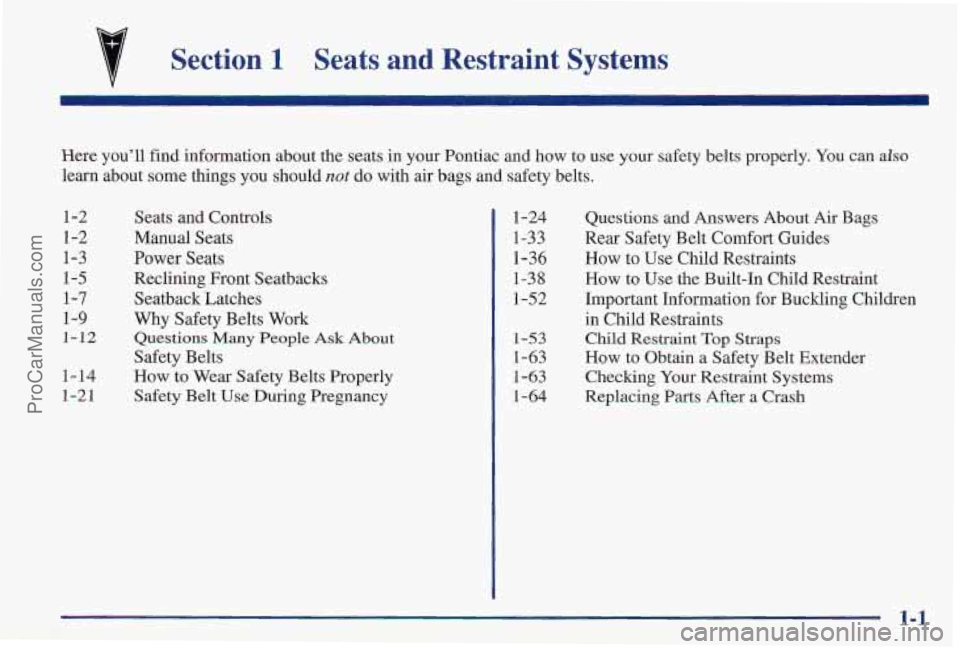
7 Section 1 Seats and Restraint Systems
Here you'll find information about the seats in your Pontiac a\
nd how to use your safety belts properly. You can also
learn about some things you should not do with air bags and safety belts.
1-2
1-2
1-3
1-5
1-1
1-9
1-12
1-14
1-21
Seats and Controls
Manual Seats
Power Seats
Reclining Front Seatbacks
Seatback Latches
Why Safety Belts Work
Questions Many People Ask About
Safety Belts
How to Wear Safety Belts Properly
Safety Belt Use During Pregnancy
1-24
1-33
1-36
1-38
1-52
1-53
1-63
1-63
1-64
Questions and Answers About Air Bags
Rear Safety Belt 'Comfort Guides
How to Use Child Restraints
How to Use the Built-In Child Restraint
Important Information
for Buckling Children
in Child Restraints
Child Restraint Top Straps
How to Obtain a Safety Belt Extender
Checking Your Restraint Systems
Replacing Parts After a Crash
1-1
ProCarManuals.com
Page 16 of 419
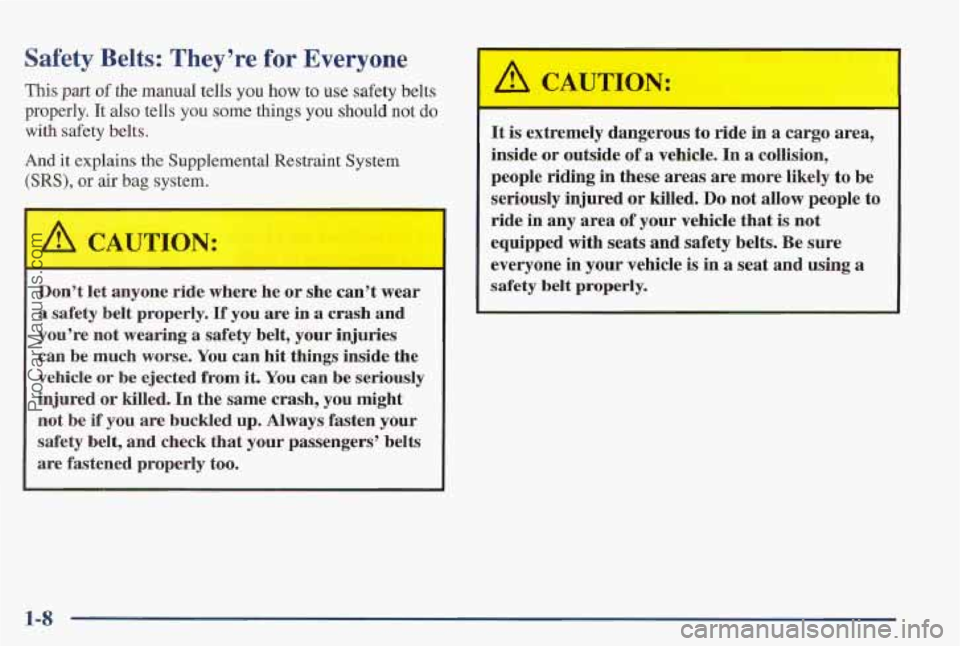
Safety Belts: They’re for Everyone
This part of the manual tells you how to use safety belts
properly. It
also tells you some things you should not do
with safety belts.
And it explains the Supplemental Restraint System
(SRS), or air bag system.
c
Don’t let anyone ride where he or she can’t wear
a safety belt properly. If you are in a crash and
you’re not wearing a safety belt, your injuries
can be much worse.
You can hit things inside the
vehicle
or be ejected from it. You can be seriously
injured or killed. In the same crash, you might
not be if
you are buckled up. Always fasten your
safety belt, and check that
your passengers’ belts
are fastened properly too.
’ A CAUTION:
It is extremely dangerous to ride in a cargo area,
inside or outside of a vehicle. In a collision,
people riding in these areas are more likely
to be
seriously injured or killed.
Do not allow people to
ride in any area
of your vehicle that is not
equipped
with seats and safety belts. Be sure
everyone in your vehicle
is in a seat and using a
safety belt properly.
1-8
ProCarManuals.com
Page 22 of 419
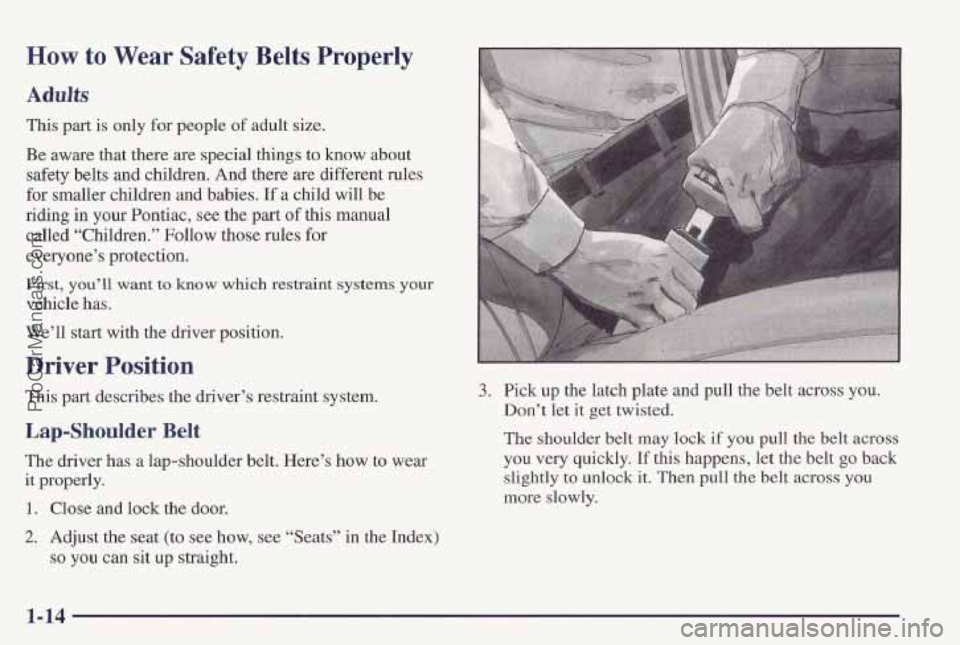
How to Wear Safety Belts Properly
Adults
This part is only for people of adult size.
Be aware that there
are special things to know about
safety belts and children. And there are different rules
for smaller children and babies. If a child will be
riding in your Pontiae, see the part of this manual
called “Children.” Follow those rules
for
everyone’s protection.
First, you’ll want to know which restraint systems your
vehicle has.
We’ll start with the driver position.
Driver Position
This part describes the driver’s restraint system.
Lap-Shoulder Belt
The driver has a lap-shoulder belt. Here’s how to wear
it properly.
I. Close and lock the door.
2. Adjust the seat (to see how, see “Seats” in the Index)
so you can sit up straight.
3. Pick up the latch plate and pull the belt across you.
Don’t let it get twisted.
The shoulder belt may
lock if you pull the belt across
you very quickly. If this happens, let the belt
go back
slightly
to unlock it. Then pull the belt across you
more slowly.
1-14
ProCarManuals.com
Page 66 of 419
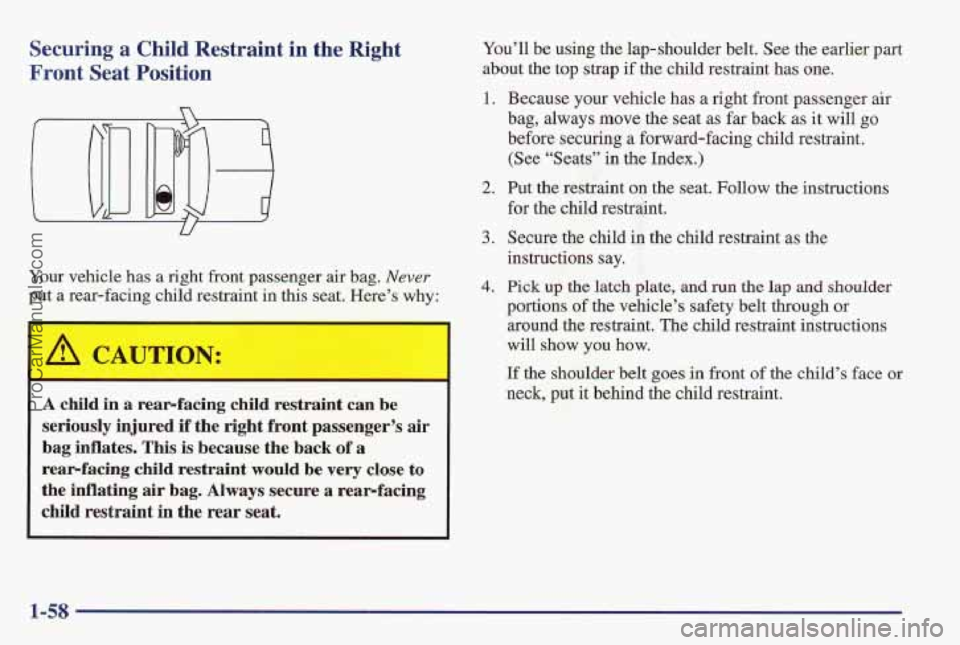
Securing a Child Restraint in the Right
Front Seat Position
Y
Your vehicle has a right front passenger air bag. Never
put a rear-facing child restraint in this seat. Here’s why:
A child in a rear-facing child restraint can be
seriously injured if the right front passenger’s air
bag inflates. This is because the back
of a
rear-facing child restraint would
be very close to
the inflating air bag. Always secure a rearfacing
child restraint
in the rear seat.
You’ll be using the lap-shoulder belt. See the earlier part
about the top strap if the child restraint has one.
1.. Because your vehicle has a right front passenger air
bag, always move the s’eat as far back as it will go
before securing a forward-facing child restraint.
(See “Seats” in the Index.)
2. Put the restraint on the seat. Follow the instructions
for the child restraint.
3. Secure the child in the child restraint as the
instructions say.
4. Pick up the latch plate, and run the lap and shoulder
portions of the vehicle’s safety belt through or
around the restraint. The child restraint instructions
will
show you how.
If the shoulder belt goes in front of the child’s face or
neck, put it behind the child restraint.
1-58
ProCarManuals.com
Page 93 of 419

Automatic Transaxle Operation
Your automatic transaxle may have a shift lever on the
steering column
or on the console between the seats.
Maximum engine speed is limited when you’re in
PARK (P) or NEUTRAL (N), to protect driveline
components from improper operation. There
are several different positions for your shift lever.
PARK (P): This locks your front wheels. It’s the best
position to use when you start your engine because your
vehicle can’t move easily.
I
It is dangerous to get out of your vehicle if the
shift lever is not fully in PARK (P) with the
parking brake firmly set. Your vehicle can roll.
Don’t leave your vehicle when the engine is
running unless you have to.
If you have left the
engine running, the vehicle can move suddenly.
You or others could be injured.
To be sure your
vehicle won’t move, even when you’re
on fairly
level ground, always set your parking brake and
move the shift lever to
PARK (P).
See “Shifting Into PARK (P)” in the Index. If
you’re pulling
a trailer, see “Towing a Trailer” in
the Index.
ProCarManuals.com
Page 169 of 419
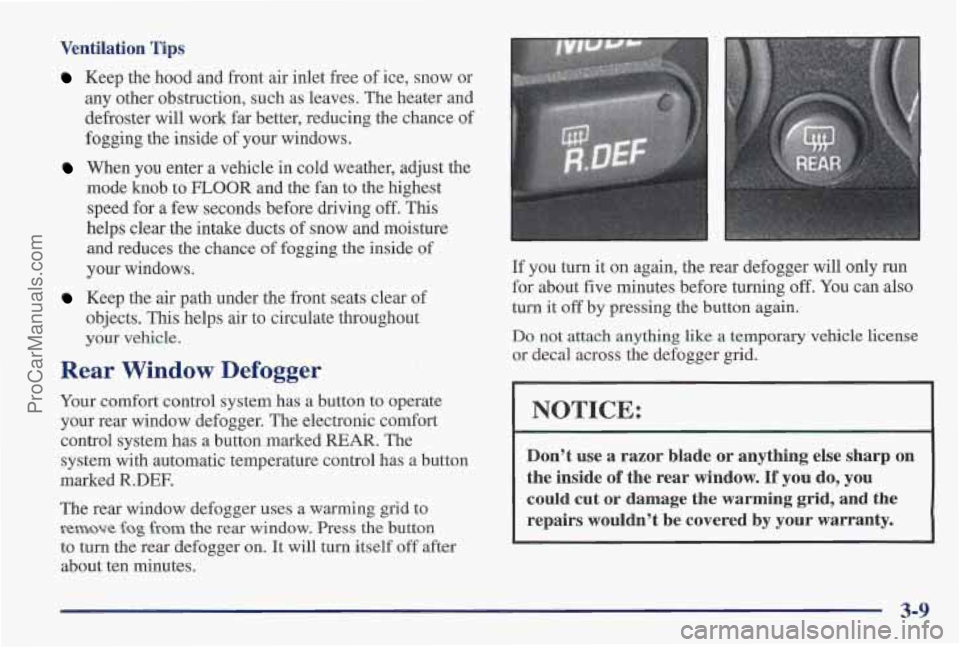
Ventilation Tips
Keep the hood and front air inlet free of ice, snow or
any other obstruction, such as leaves. The heater and
defroster will work far better, reducing the chance of
fogging the inside of your windows.
When you enter a vehicle in cold weather, adjust the
mode knob to
FLOOR and the fan to the highest
speed for a few seconds before driving off. This
helps clear the intake ducts of snow and moisture
and reduces the chance
of fogging the inside of
your windows.
Keep the air path under the front seats clear of
objects. This helps air to circulate throughout
your vehicle.
Rear Window Defogger
Your comfort control system has a button to operate
your rear window defogger. The electronic comfort control system has a button marked
REAR. The
system with automatic temperature control has a button
marked
R.DEF.
The rear window defogger uses a warming grid to
K~~OW fog from the rear window. Press the button
to turn the rear defogger on. It will turn itself off after
about ten minutes.
If you turn it on again, the rear defogger will only run
for about five minutes before turning off.
You can also
turn it off by pressing the button again.
Do not attach anything like a temporary vehicle license
or decal across the defogger grid.
NOTICE:
Don’t use a razor blade or anything else sharp on
the inside
of the rear window. If you do, you
could cut or damage the warming grid, and the
repairs wouldn’t be covered by
your warranty.
3-9
ProCarManuals.com
Page 225 of 419

I
Towing a Trailer
Things you put inside your vehicle can strike
and injure people
in a sudden stop or turn, or
in
a crash.
Put things in the trunk of your vehicle. In a
1 trunk, put them as far forward as you can.
Never stack heavier things, like suitcases,
Try to spread the weight evenly.
inside the vehicle
so that some of them are
above the tops
of the seats.
Don’t leave an unsecured child restraint in
your vehicle.
When you carry something inside the
’ vehicle, secure it whenever you can.
Don’t leave a seat folded down unless you
need to.
If you don’t use the correct equipment and drive
properly, you can lose control when you pull
a
trailer. For example, if the trailer is too heavy, the
brakes may not work well
-- or even at all. You
and your passenger passengers could be seriously
injured. Pull
a trailer only if you have followed
all the steps in this section. Ask your Pontiac
dealer
for advice and information about towing a
trailer
with your vehicle.
4-31
ProCarManuals.com